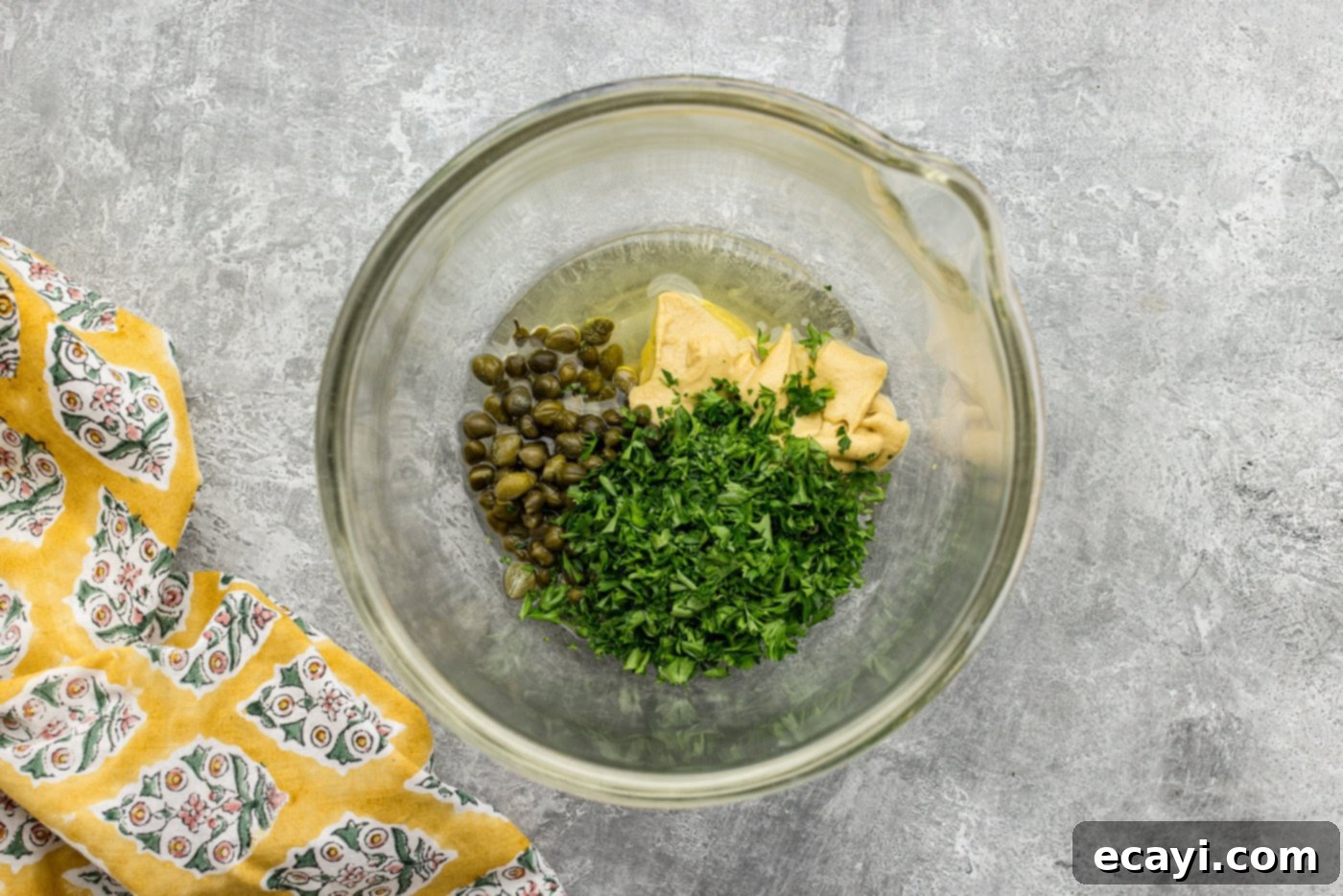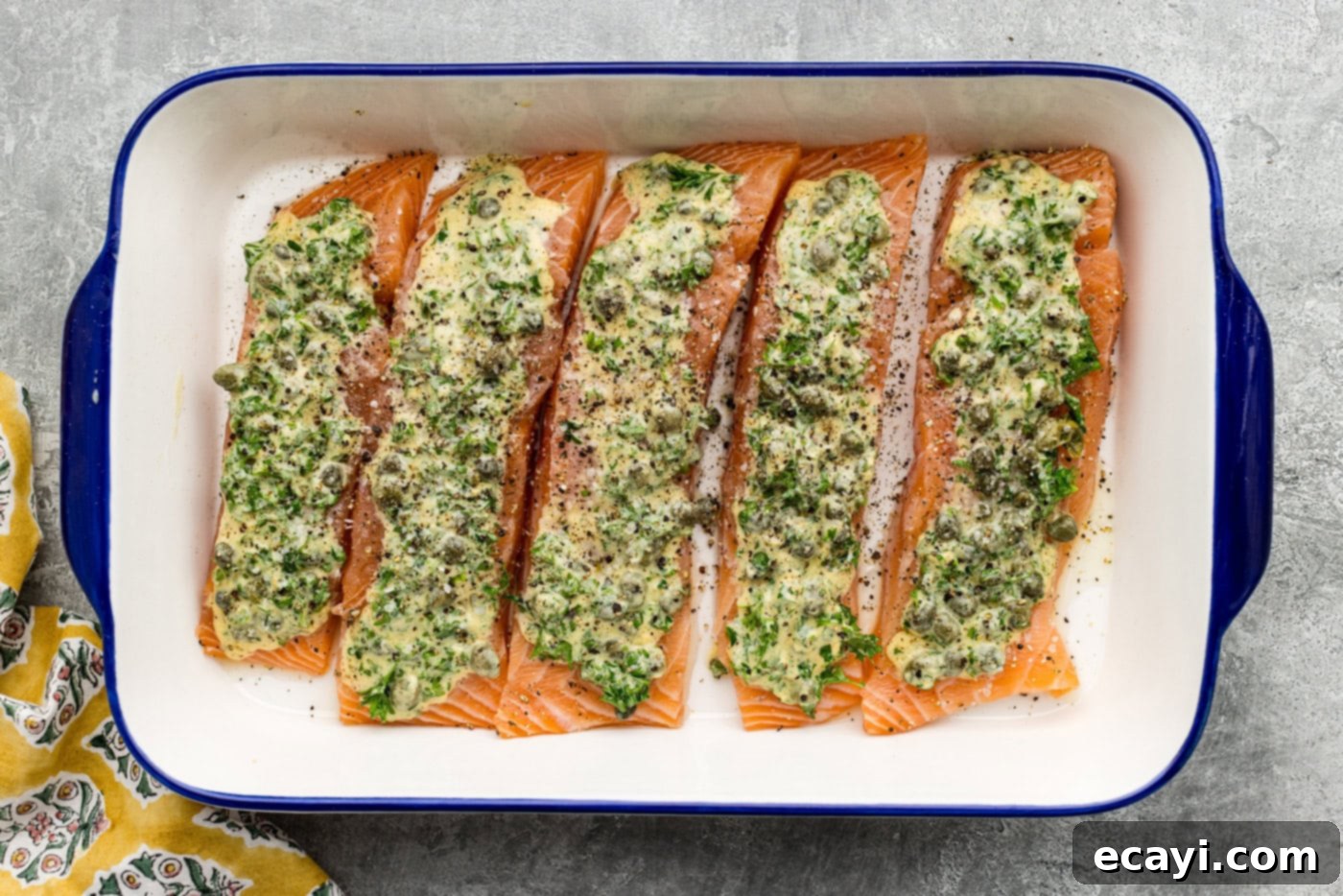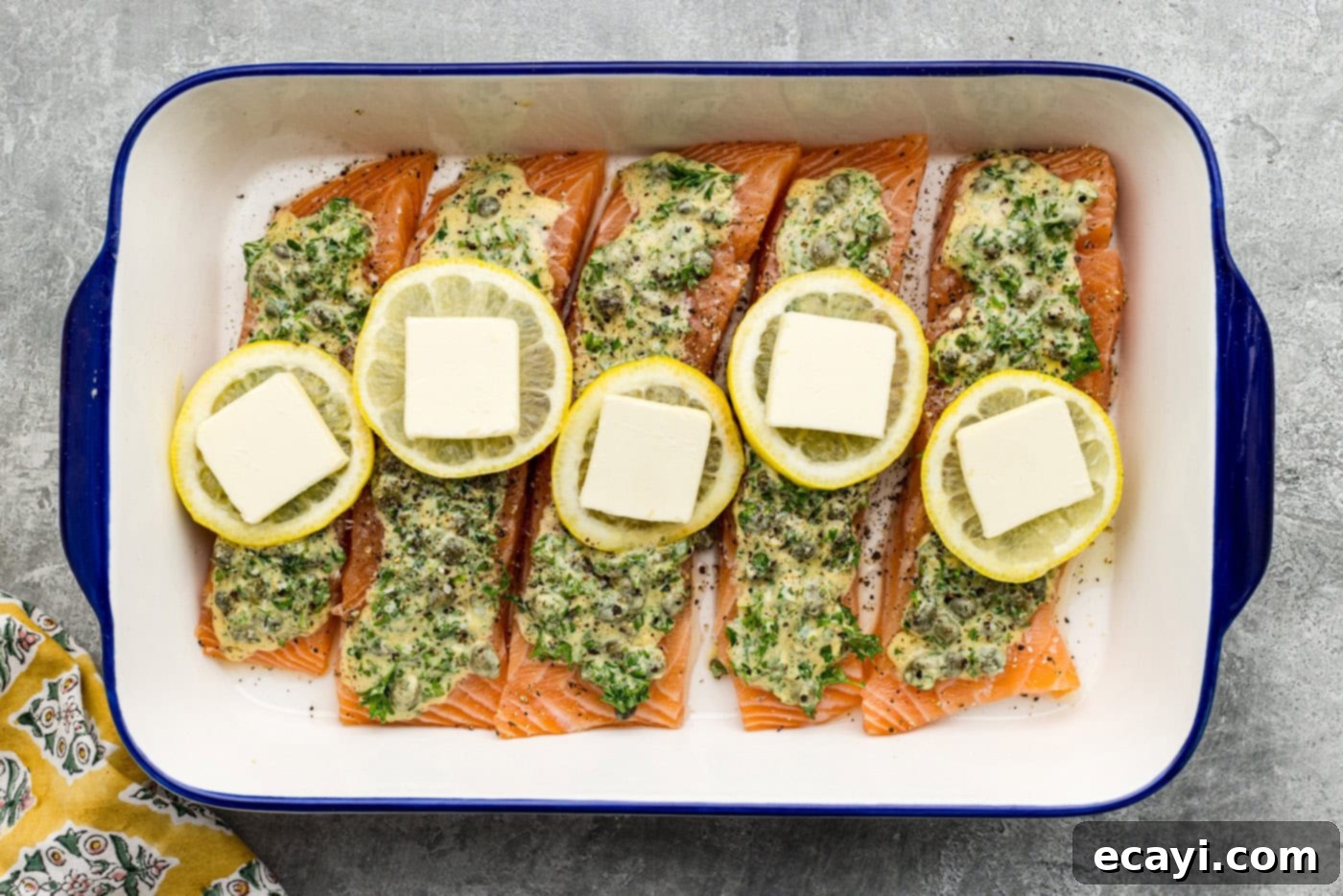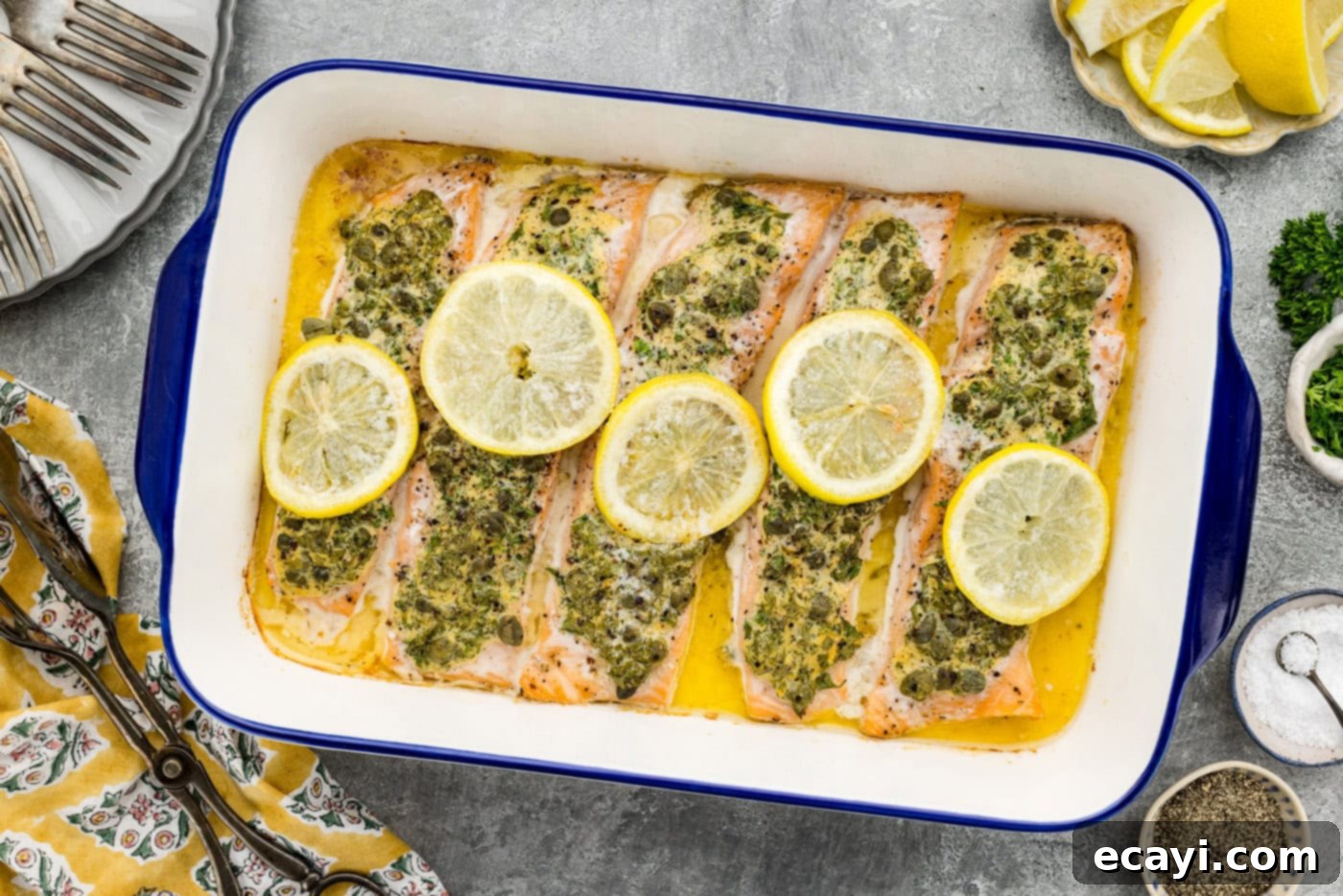Delicious & Easy Baked Lemon Caper Salmon: A Zesty Weeknight Dinner Recipe
Prepare to elevate your weeknight dinner with this incredibly flavorful Lemon Caper Salmon recipe. It’s a dish that masterfully blends the rich, buttery notes of perfectly cooked salmon with a vibrant symphony of briny capers, bright lemon juice, and the subtle tang of Dijon mustard. If you’re looking for a meal that tastes gourmet but is surprisingly simple to prepare, this oven-baked salmon is your answer. Forget bland fish; every succulent bite of this marinated salmon is a testament to fresh, zesty goodness, ensuring your taste buds are anything but bored.
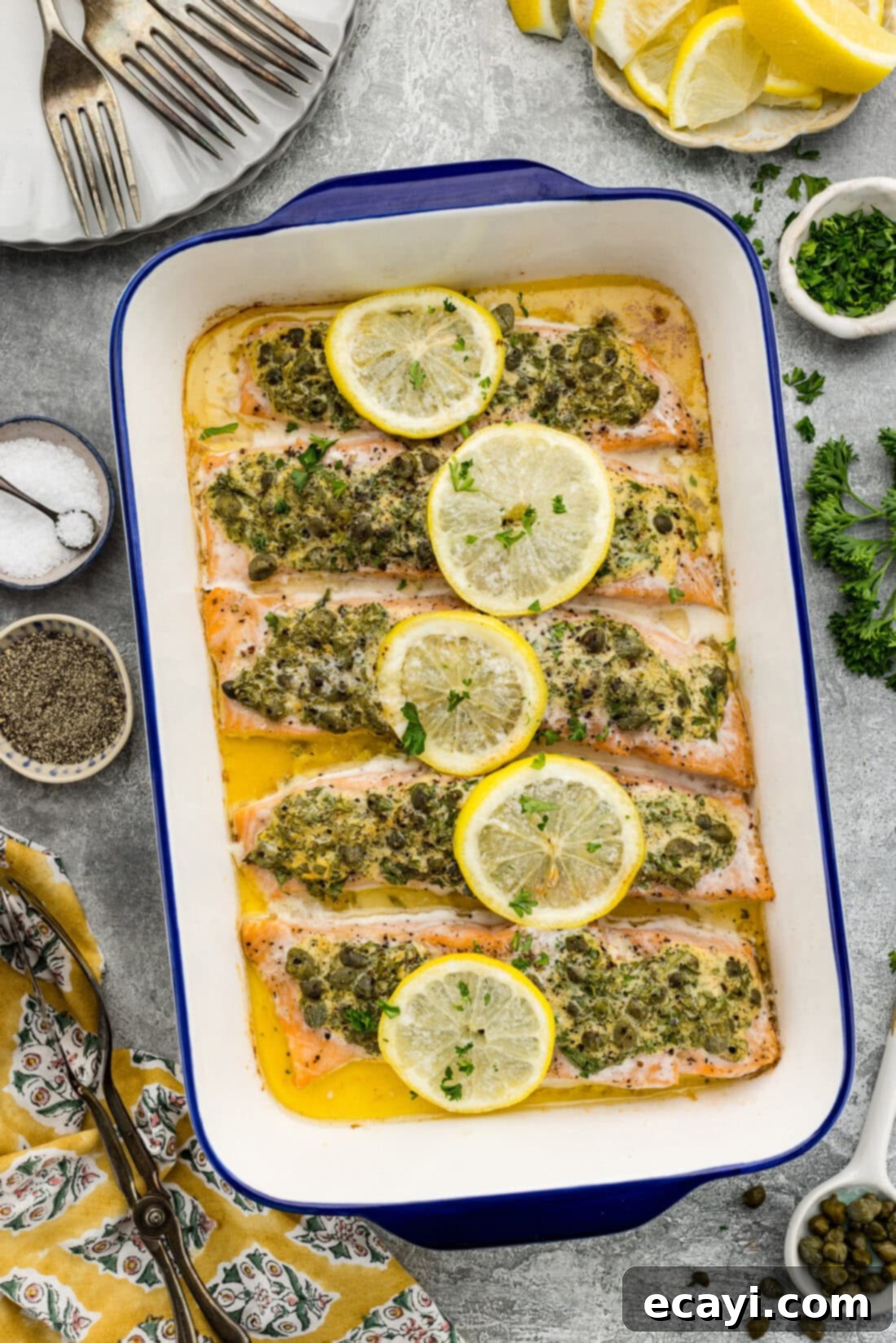
Why This Lemon Caper Salmon Recipe Is a Must-Try
The secret to truly outstanding fish often lies in a well-crafted marinade, and this lemon caper salmon recipe hits all the right notes. The thoughtfully balanced blend of olive oil, fresh lemon, Dijon, capers, and parsley not only infuses the salmon with incredible flavor but also helps to tenderize the fillets, resulting in a moist and flaky texture. The beauty of this recipe is its flexibility; while the salmon benefits from a longer soak in the marinade, even a quick 30-minute marination will yield an impressively delicious outcome. This makes it perfect for both spontaneous dinners and planned meals.
Salmon, known for its rich, buttery texture and healthy omega-3 fats, serves as the ideal canvas for the vibrant flavors of this dish. The capers deliver a delightful briny and salty burst that perfectly complements the fresh, tangy zest of lemon juice. A touch of Dijon mustard adds a subtle sharpness and acts as an emulsifier, binding all the marinade components together beautifully. This combination creates a harmonious flavor profile that is both sophisticated and incredibly satisfying – truly a chef’s kiss moment you can recreate in your own kitchen!
RELATED – Not a huge fan of capers, or prefer a simpler lemon salmon? You’ll probably enjoy my baked lemon salmon recipe instead for a classic, bright flavor!
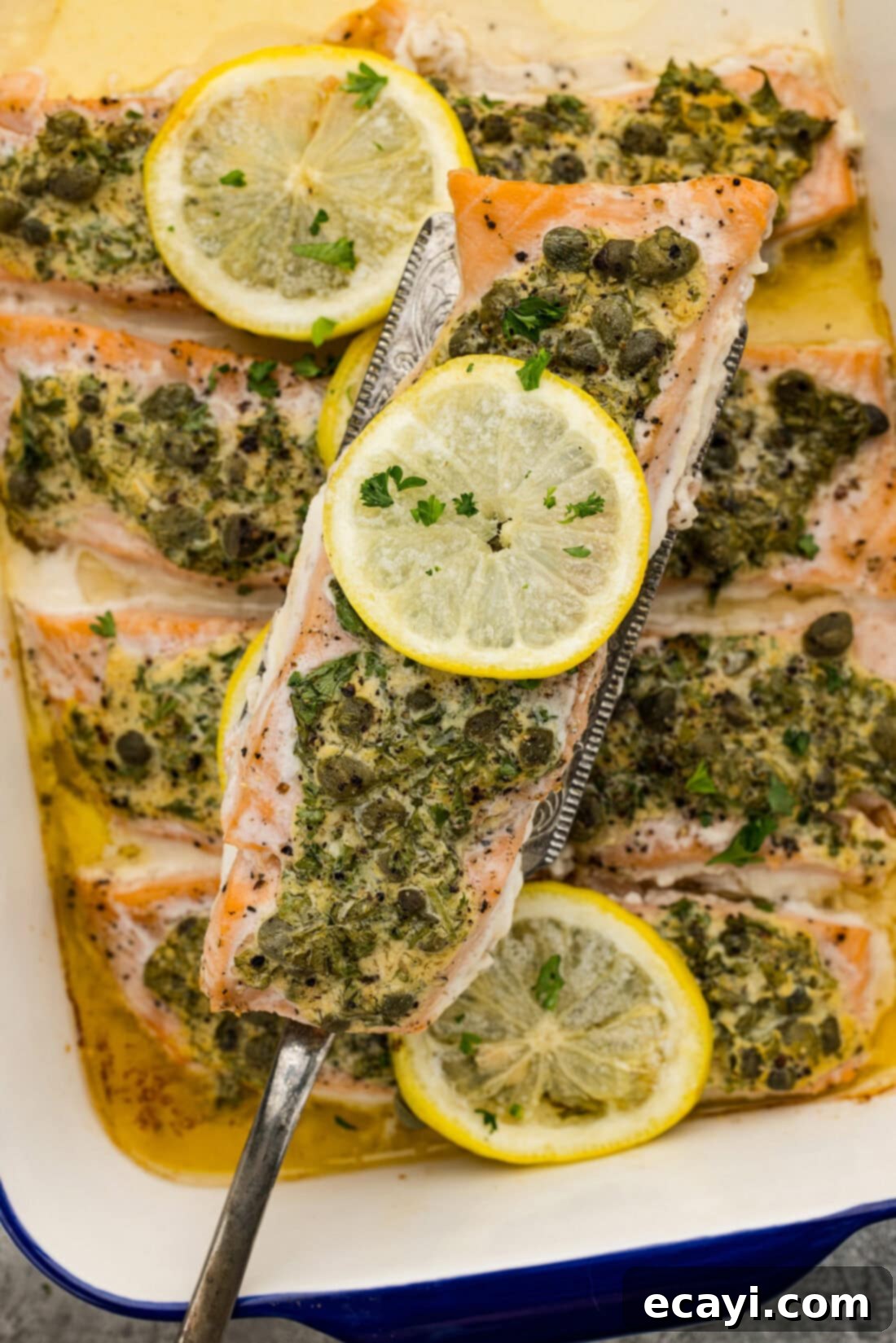
Key Ingredients for Your Lemon Caper Salmon
Gathering your ingredients is the first step to creating this delightful salmon dish. While the full list with precise measurements can be found in the printable recipe card at the end of this post, here’s a quick overview of what you’ll need and why each component is essential for that perfect briny, zesty, and buttery flavor.
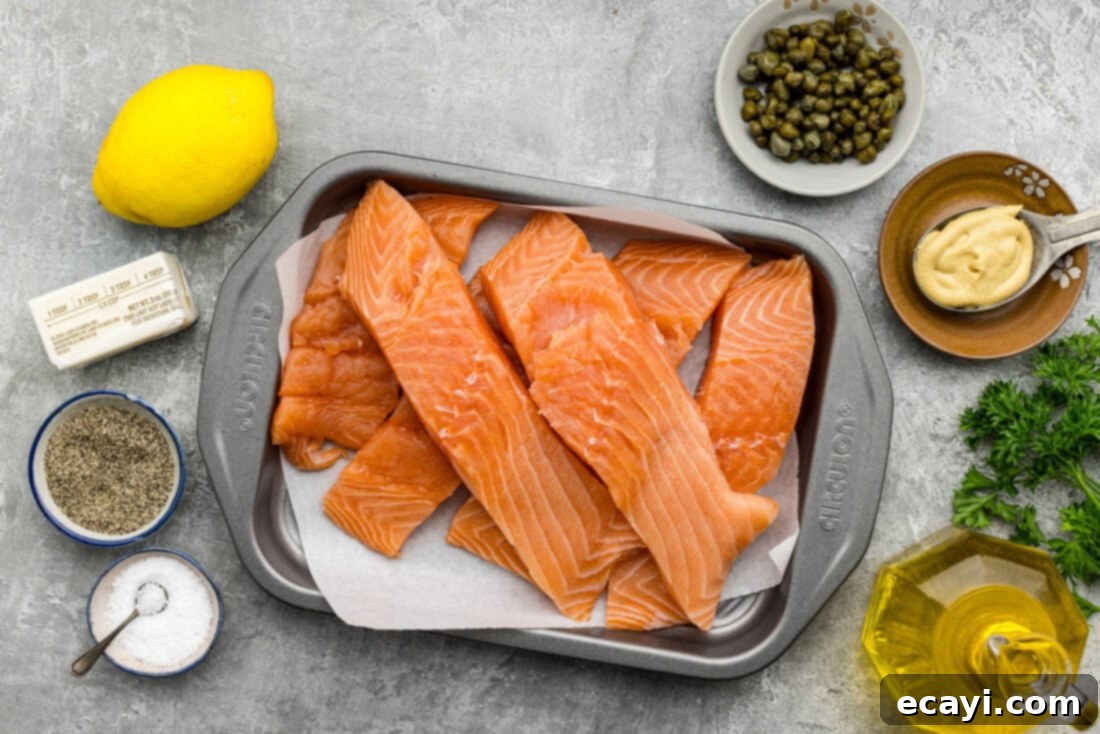
Ingredient Spotlight & Smart Substitutions
Let’s dive deeper into the individual components that make this Lemon Caper Salmon so special. Understanding each ingredient’s role will help you achieve the best results and make informed substitutions if needed.
- SALMON – The star of our dish! We initially tested this recipe with luscious New Zealand King Salmon, known for its exceptional butteriness and melt-in-your-mouth texture. However, any good quality salmon will yield fantastic results. Look for vibrant, firm fillets, whether it’s Atlantic, Sockeye, or Coho. Center-cut salmon is highly recommended because its uniform thickness ensures that each filet cooks evenly, preventing some pieces from drying out while others are still undercooked. When selecting your salmon, aim for fillets that are about 1-inch thick for optimal baking time.
- OLIVE OIL – Extra virgin olive oil forms the base of our marinade, helping to carry the flavors and keep the salmon moist during baking. It also contributes a subtle fruity note that complements the other ingredients. A good quality olive oil can make a difference in the overall taste.
- FRESH SQUEEZED LEMON JUICE – This is non-negotiable for that bright, zesty kick! Freshly squeezed lemon juice provides a vibrant acidity that cuts through the richness of the salmon and the brininess of the capers. Bottled lemon juice simply won’t offer the same fresh, aromatic quality. You’ll need about half a lemon for the marinade, but grab an extra one for lemon wedges to serve alongside the finished dish.
- DIJON MUSTARD – Dijon is more than just a flavor enhancer here; it plays a crucial role as an emulsifier, helping to bind the oil and lemon juice together in the marinade. Its distinctive tangy, slightly spicy flavor adds depth and complexity without overpowering the delicate salmon. Whole grain Dijon can also be used for a textural element.
- CHOPPED FRESH PARSLEY – Fresh herbs are key! Parsley adds a fresh, herbaceous aroma and a pop of green color to the dish. Flat-leaf (Italian) parsley is generally preferred for its bolder flavor compared to curly parsley. While dried parsley can be used in a pinch, fresh is highly recommended for the best flavor and presentation. You’ll need some for the marinade and extra for garnish.
- CAPERS – These tiny, briny flower buds are essential to the “caper” in Lemon Caper Salmon. They bring a distinct salty, slightly floral, and tangy flavor that perfectly complements the salmon and lemon. Ensure your capers are well-drained before adding them to the marinade. If you find their brininess too intense, you can quickly rinse them under cold water before draining, though it’s usually not necessary for this recipe. If you really dislike capers, you can omit them or try finely chopped olives for a similar salty punch.
- UNSALTED BUTTER – A few pats of butter melted over the salmon fillets add an extra layer of richness and help keep the fish incredibly moist and tender during baking. For a dairy-free option, coconut oil can be substituted in the same amount, though it will impart a slightly different flavor.
- KOSHER SALT AND FRESH GROUND BLACK PEPPER – Essential seasonings to taste, these elevate all the other flavors. Start with about 1/4 teaspoon of each and adjust according to your preference. Remember, capers are salty, so be mindful when adding extra salt.
How to Make Delicious Lemon Caper Salmon
These step-by-step photos and instructions are here to help you visualize how to make this recipe. You can Jump to Recipe to get the printable version of this recipe, complete with measurements and instructions at the bottom.
- Preheat your oven: Begin by preheating your oven to 350 degrees F (175 degrees C). This ensures the oven is at the correct temperature for even cooking once the salmon is ready to go in.
- Prepare the salmon fillets: Arrange your salmon fillets in a 9×13-inch baking pan. Make sure they are laid in a single layer to allow for even cooking. If your fillets are skin-on, place them skin-side down. Pat the salmon dry with paper towels; this helps the marinade adhere better and can contribute to a better texture.
- Whisk the vibrant marinade: In a medium-small mixing bowl, combine the olive oil, freshly squeezed lemon juice, Dijon mustard, finely chopped fresh parsley, and the well-drained capers. Whisk all these ingredients vigorously until they are thoroughly combined and create a beautifully emulsified, fragrant marinade. This mixture is the heart of the dish’s flavor!

- Coat and season the salmon: Evenly spread the prepared marinade mixture over the top of each salmon fillet until they are fully coated. Don’t be shy; ensure every part of the salmon gets a generous layer of this flavorful goodness. Then, season liberally with kosher salt and freshly ground black pepper to taste. For an extra touch of flavor and moisture, add a few thin lemon slices to the top of each fillet, if desired. On top of each lemon slice, place a tablespoon of unsalted butter, which will melt and baste the salmon as it bakes, keeping it moist and adding richness.


- Marinate for optimal flavor: Cover the baking pan tightly with plastic wrap and refrigerate. Allow the salmon to marinate for at least 30 minutes to an hour for good flavor absorption. For an even more intense and delicious result, you can marinate the salmon overnight, allowing the flavors to truly meld. Just ensure it’s kept refrigerated and well-sealed.
- Bake to perfection: Once marinated, remove the salmon from the refrigerator and place it into the preheated oven. Bake for 20-30 minutes. The exact baking time will depend on the thickness of your salmon fillets, so start checking for doneness around the 20-minute mark. Cooked salmon should flake easily when gently pressed with a fork in its thickest portion, but still appear moist and slightly translucent in the center. Avoid overcooking, as stiff or firm salmon indicates it has become dry.

- Serve and enjoy: Once baked, remove the pan from the oven. Optionally, garnish with a sprinkle of freshly chopped parsley for extra freshness and color, and adjust salt and pepper to taste one last time if desired. Serve immediately and enjoy your perfectly cooked, flavor-packed Lemon Caper Salmon!
Frequently Asked Questions & Expert Tips
Absolutely! This recipe is fantastic for meal planning. You can prepare the salmon and allow it to marinate in the refrigerator the night before or the morning of your dinner. This helps to reduce stress during busy dinner times, allowing the flavors to develop even further. Just be sure to cover the baking dish tightly with plastic wrap to keep the salmon fresh and prevent any odors from escaping into your fridge.
Store any cooled leftover lemon caper salmon in an air-tight container in the refrigerator for 3-4 days. When reheating, salmon can easily dry out. To gently warm it while preserving moisture, I recommend placing the salmon on a baking sheet, wrapping it loosely with aluminum foil, and reheating in a 275°F (135°C) oven for about 10-15 minutes, or until just warmed through. Adding a tiny splash of water or a small pat of extra butter to the foil packet before reheating can also work wonders in keeping the salmon moist and flaky.
The best and most reliable way to check for doneness in salmon is by using an instant-read thermometer. Insert it into the thickest portion of the fillet; the ideal internal temperature for medium-cooked salmon is 125-130°F (52-54°C), and for well-done salmon, it’s 140°F (60°C). If you don’t have a thermometer, gently press the center of the fillet with a fork. If it flakes easily but still appears slightly moist and opaque (not raw) in the center, it’s done. Avoid cooking until it’s completely firm or stiff, as this indicates overcooked, dry salmon.
While this recipe is designed for baking, you can adapt it for other cooking methods. For grilling, preheat your grill to medium-high heat. Place the marinated salmon skin-side down on aluminum foil or directly on a clean, oiled grill grate. Grill for about 4-6 minutes per side, depending on thickness, until it reaches desired doneness. For pan-searing, heat a skillet over medium-high heat with a tablespoon of olive oil. Sear the salmon skin-side down for 5-7 minutes, then flip and cook for another 3-5 minutes, or until cooked through. Adjust marinade coverage to prevent burning if searing.
Salmon is a powerhouse of nutrition! It’s famously rich in Omega-3 fatty acids, which are vital for heart health, brain function, and reducing inflammation. It’s also an excellent source of high-quality protein, essential vitamins like B12 and D, and minerals such as selenium and potassium. Incorporating salmon into your diet regularly can contribute to overall well-being and provide a delicious way to meet your nutritional needs.
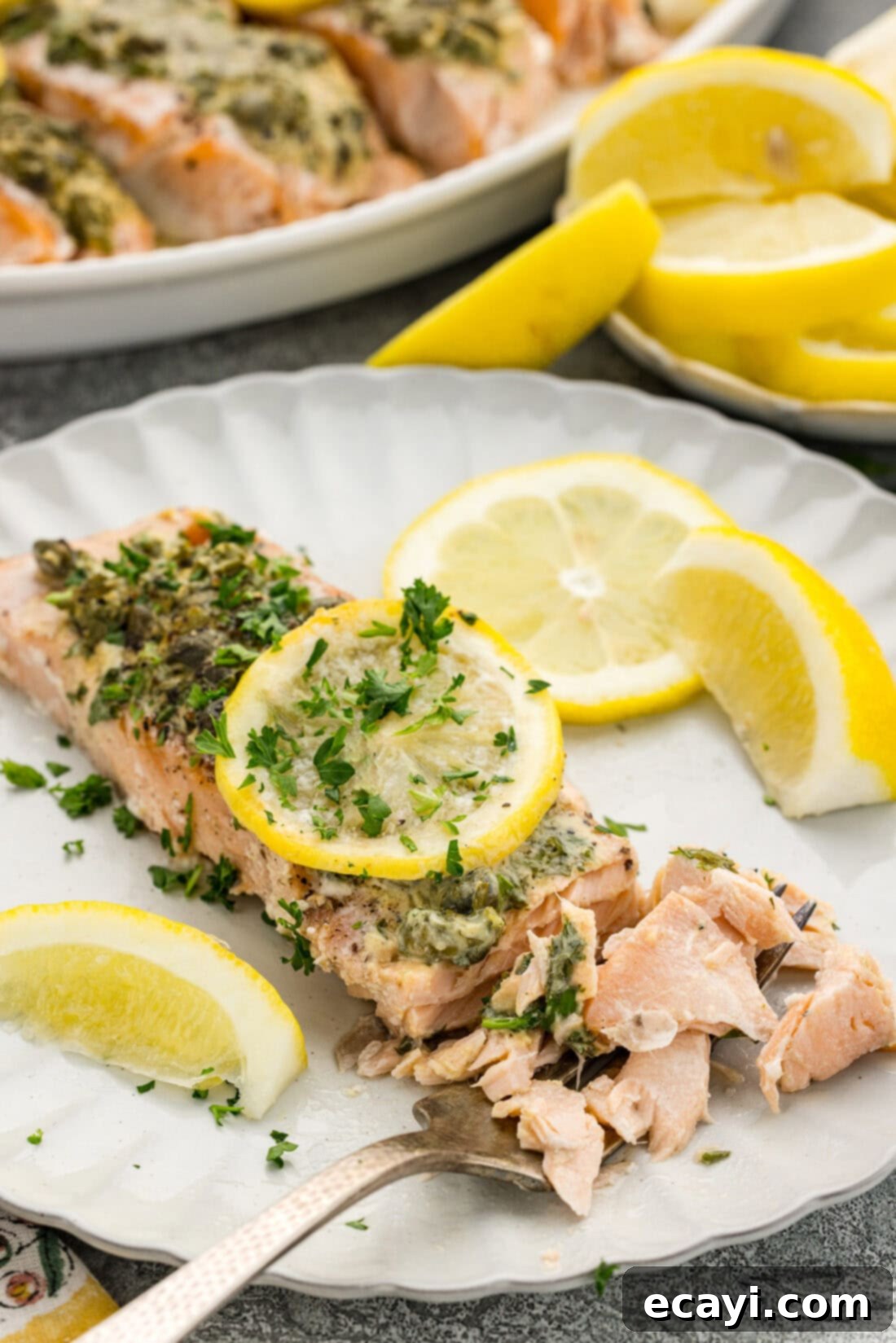
Delicious Serving Suggestions for Lemon Caper Salmon
This versatile lemon caper salmon pairs beautifully with a variety of side dishes, making it perfect for any meal. For a complete and wholesome dinner, consider serving it with roasted green beans, tender asparagus, crispy Brussels sprouts, or fluffy roasted potatoes. The bright flavors of the salmon also complement grains exceptionally well; try it with light and fluffy rice, delicate orzo, or a citrusy lemon couscous for an extra burst of freshness. A simple green salad with a light vinaigrette is also an excellent choice.
Don’t let any leftovers go to waste! Cooked lemon caper salmon is fantastic for meal prep throughout the week. Flake the salmon into a fresh, crisp salad for a light lunch, or gently reheat and pack it with your favorite grain and vegetable sides for a satisfying packed lunch. Its robust flavor stands up well, making it a delicious and healthy option for busy schedules.
Explore More Delicious Salmon Recipes
If you’ve enjoyed this Lemon Caper Salmon, you’re in for a treat! Salmon is an incredibly versatile fish that can be prepared in countless delicious ways. Expand your culinary repertoire with these other fantastic salmon recipes:
- Zesty Salmon Tacos: A fresh and flavorful twist on taco night.
- Classic Baked Salmon: A straightforward and healthy preparation for any occasion.
- Sweet & Savory Teriyaki Salmon: Perfect for those who love an Asian-inspired glaze.
- Irresistible Brown Sugar Salmon: A wonderfully caramelized and slightly sweet option.
I love to bake and cook and share my kitchen experience with all of you! Remembering to come back each day can be tough, that’s why I offer a convenient newsletter every time a new recipe posts. Simply subscribe and start receiving your free daily recipes!
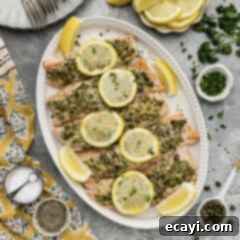
Lemon Caper Salmon
IMPORTANT – There are often Frequently Asked Questions within the blog post that you may find helpful. Simply scroll back up to read them!
Print It
Pin It
Rate It
Save ItSaved!
Ingredients
- 2 pounds salmon about 5 filets. ideally center-cut salmon
- 2 Tablespoons olive oil
- 2 Tablespoons fresh squeezed lemon juice 1/2 lemon, get a couple lemons for this recipe so you have wedges for serving
- 2 Tablespoons Dijon mustard
- ¼ cup chopped parsley plus more for serving
- 1-2 Tablespoons capers drained
- 4-5 Tablespoons unsalted butter can substitute same amount coconut oil
- kosher salt and fresh ground black pepper to taste start with 1/4 tsp. of each
Things You’ll Need
-
13×9 baking dish
Before You Begin
- We initially used New Zealand King Salmon for this recipe, known for its buttery and rich flavor. However, any good quality salmon, such as Atlantic or Coho, will work beautifully. We highly recommend using center-cut salmon as its uniform thickness ensures that each fillet cooks evenly, resulting in perfectly tender and moist fish every time.
- For perfectly cooked salmon that isn’t dry, the best method to test for doneness is with an instant-read thermometer. Inserted into the thickest part of the fillet, aim for an internal temperature of 125-130°F (52-54°C) for medium-cooked salmon, or 140°F (60°C) for well-done. If a thermometer isn’t available, gently press the center of the fillet with a fork; it should flake easily and still appear moist and slightly opaque inside.
Instructions
-
Preheat oven to 350 degrees F (175°C).
-
Arrange salmon fillets in a 9×13-inch baking pan, ensuring they are in a single layer for even cooking.2 pounds salmon
-
In a medium-small mixing bowl, whisk together the olive oil, freshly squeezed lemon juice, Dijon mustard, chopped parsley, and drained capers until well combined.2 Tablespoons olive oil, 2 Tablespoons fresh squeezed lemon juice, 2 Tablespoons Dijon mustard, 1/4 cup chopped parsley, 1-2 Tablespoons capers
-
Evenly spread the mixture over the top of the salmon fillets until fully coated. Season with salt and pepper to taste. If desired, add lemon slices to each filet and place a tablespoon of unsalted butter over each lemon slice.4-5 Tablespoons unsalted butter
-
Cover the baking pan with plastic wrap and refrigerate for at least 30 minutes, or longer if time permits (you can also marinate overnight for enhanced flavor).
-
Bake salmon for 20-30 minutes. Begin checking at the 20-minute mark for doneness. Baking time will vary based on fillet thickness. The salmon is done when it flakes easily with a fork in the thickest part but still looks moist inside; stiff or firm salmon indicates it’s overcooked.
-
Optionally top with freshly chopped parsley before serving. Enjoy immediately!
Expert Tips & FAQs
- You can prep the salmon and allow it to rest in the marinade the night before or the morning of to take some stress off dinner time. Be sure to cover it well with plastic wrap and keep it refrigerated.
- Store any cooled leftovers in an air-tight container kept in the refrigerator for 3-4 days. Reheat gently in a 275F (135°C) oven. I would recommend wrapping the salmon loosely with foil and placing it on a baking sheet. Salmon tends to dry out when reheated, so a splash of water or extra butter will help keep it moist.
- For the freshest flavor, always use freshly squeezed lemon juice rather than bottled. The brightness it brings is unmatched.
- Don’t be afraid to adjust the amount of capers to your preference. If you love a briny kick, add a little extra; if you prefer it milder, use less.
Nutrition
The recipes on this blog are tested with a conventional gas oven and gas stovetop. It’s important to note that some ovens, especially as they age, can cook and bake inconsistently. Using an inexpensive oven thermometer can assure you that your oven is truly heating to the proper temperature. If you use a toaster oven or countertop oven, please keep in mind that they may not distribute heat the same as a conventional full sized oven and you may need to adjust your cooking/baking times. In the case of recipes made with a pressure cooker, air fryer, slow cooker, or other appliance, a link to the appliances we use is listed within each respective recipe. For baking recipes where measurements are given by weight, please note that results may not be the same if cups are used instead, and we can’t guarantee success with that method.
This recipe was originally contributed by our friend Sara over at Life’s Little Sweets.
